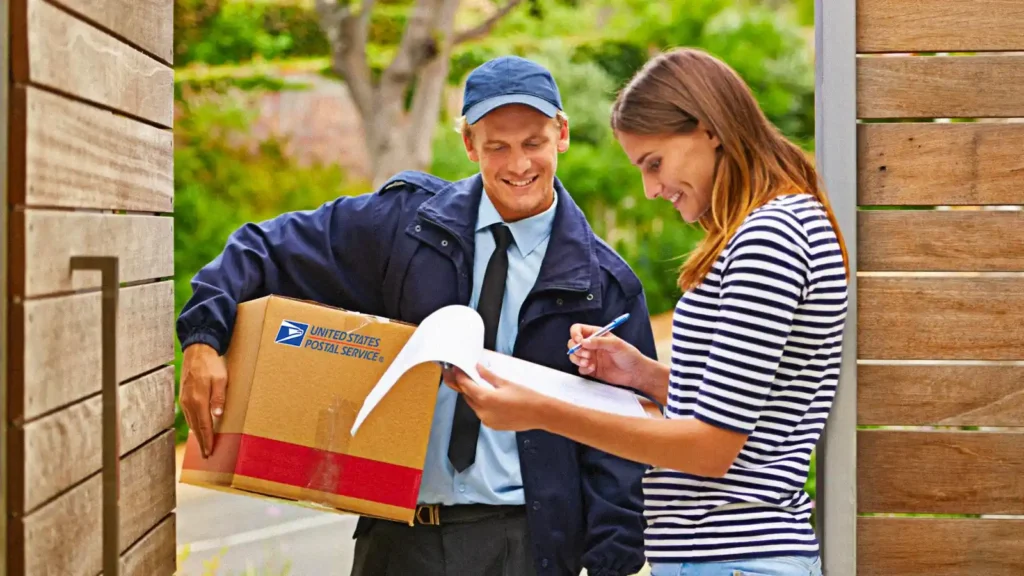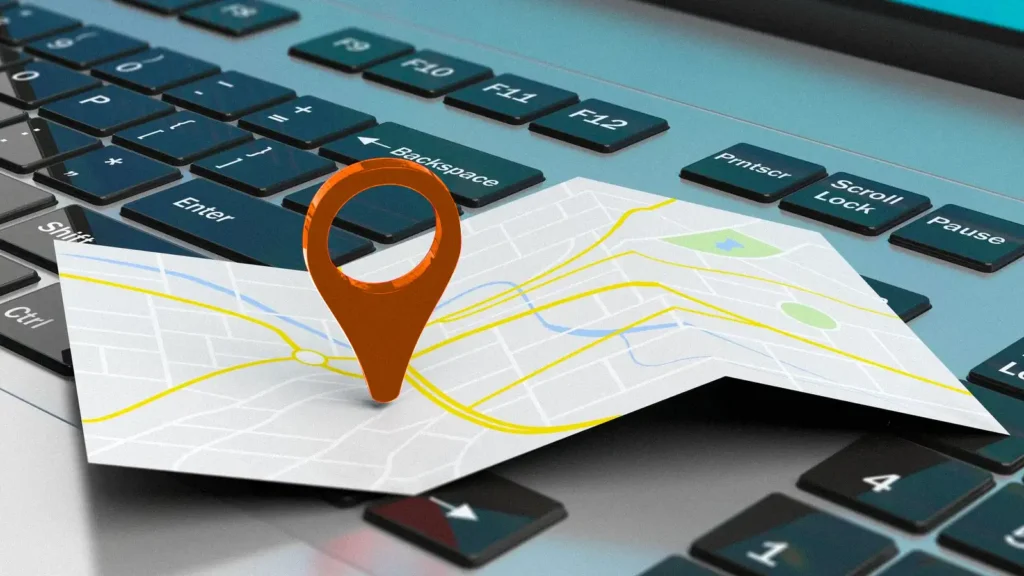Ever wondered how your mail reaches you seamlessly from one end of the country to another? The United States Postal Service (USPS) plays a pivotal role in delivering millions of mail pieces daily, ensuring each piece of mail reaches its destination promptly and securely.
The secret behind this impressive feat? Well, it’s all in the numbers! The five-digit codes you see on every piece of mail, known as zip codes, are instrumental in guiding your mail to its destination efficiently. Understanding the “mail delivery time from zip code to zip code” can help you estimate when your mail will arrive at its destination.
Key Takeaways
- Understand USPS mail services and the role of zip codes in delivery.
- Take into account factors such as holidays, weather conditions, and mail volume when estimating delivery time.
- Utilize USPS tools for accurate estimates and consider using virtual mailbox services to ensure timely delivery.

Understanding USPS Mail Services
The United States Postal Service offers a diverse range of mail services, each tailored to cater to specific needs, delivery times, and security levels. These services range from First-Class Mail, a popular choice for sending lightweight packages, to USPS Retail Ground, a cost-effective solution for sending heavier packages.
The USPS even offers domestic express mail for urgent deliveries, ensuring your domestic and international mail reaches its destination promptly, regardless of whether it’s within the same zip code or across the country.
Below are four of the USPS services with information and details on each:
- First-Class Mail
- First-Class Mail is a popular USPS service, prized for its cost-effectiveness and speedy delivery.
- It shines when it comes to sending direct mail, with a majority of items arriving within a brisk one to three business days.
- Wondering how to figure out the local delivery time? Don’t fret! The official USPS website provides a straightforward method to estimate the delivery time from one zip code to another.
- Keep in mind, however, that certain factors might cause delays in First-Class Mail deliveries.
- Elements like the distance between locations, unfavorable weather, and the remoteness of the sender or recipient’s location can all play a part in slowing down deliveries.
- These factors can likewise affect international mail delivery times.
- First-Class Mail is a popular USPS service, prized for its cost-effectiveness and speedy delivery.
- Priority Mail
- Priority Mail is another favored USPS service, fashioned to deliver packages of different sizes within a brief span of 1-3 business days.
- The service is lauded for its flat rate boxes and envelopes, which facilitate shipping items for a uniform price, irrespective of their weight or destination, assuming they fit within the specified USPS boxes or envelopes.
- Despite its pledge for swift delivery, Priority Mail is not impervious to possible delays. While the service targets a 1-3 day delivery, these timelines are not assured, and the likelihood of encountering delays is still a possibility.
- Priority Mail Express
- If time is of the essence, Priority Mail Express, also known as priority express mail, serves as the USPS’s swiftest service, offering overnight or next-day delivery depending on the destination.
- Operating seven days a week, this service shines for urgent deliveries. To guarantee timely delivery, your package should be prepared for mailing by 10:30 AM.
- And don’t worry about the weight – Priority Mail Express allows for the shipment of packages that weigh up to 70 lbs.
- Media Mail
- Seeking an economical means to dispatch educational materials? Turn to Media Mail. This shipping service is crafted specifically for transporting eligible items like:
- Books
- Sound recordings
- Playscripts
- Manuscripts for books and periodicals
- Packages can weigh as much as 70 pounds and have a combined length and girth of up to 108 inches.
- The cost of USPS Media Mail is determined based on the weight of the package, with the initial pound incurring a flat rate of $2.80 and each additional pound adding $0.53 to the cost.
- With an estimated delivery time of 2 to 8 business days, this service offers a cost-effective solution for those without urgent delivery needs.
- Seeking an economical means to dispatch educational materials? Turn to Media Mail. This shipping service is crafted specifically for transporting eligible items like:

The Role of Zip Codes in Mail Delivery
Zip codes, the five-digit numbers seen on every mail item, are the backbone of USPS’s mail delivery system. They play a crucial role in determining the delivery routes and times, thereby ensuring that your mail reaches its destination efficiently.
Be it a letter, a postcard, or a package, every piece of mail relies on these codes for its journey from one location to the zip code of the recipient.
- Types of Zip Codes
- Zip codes aren’t as simple as they seem. The USPS employs various types of zip codes to cater to the diverse mailing requirements. For instance, there is:
- The standard 5-Digit ZIP Code that represents a USPS delivery area.
- The ZIP+4 Code, an extended version that includes an additional four digits to specify a more precise location.
- The Delivery Point Code, which provides further information along with the 5-digit ZIP code.
- The Plus-Four Codes, also known as ‘add-on codes,’ which are used in addresses with a full nine-digit code.
- Each digit in a zip code has unique significance. The first digit signifies a specific state or group of States in the United States, while the fourth and fifth digits serve to refine the address to a specific street or region.
- USPS also utilizes Zip Code suffixes to enhance the efficiency of mail sorting and distribution, leading to expedited and precise deliveries.
- Zip codes aren’t as simple as they seem. The USPS employs various types of zip codes to cater to the diverse mailing requirements. For instance, there is:
- Distance Between Zip Codes
- While zip codes might seem like just numbers, their impact on mail delivery times is significant. The distance between two zip codes can greatly influence the time it takes for a mail or package to be delivered.
- For instance, sending a letter from New York City to Los Angeles typically takes longer than sending a letter within New York City itself.
- The typical delivery time for mail sent between distant zip codes in the United States generally ranges from two to five days. However, these delivery times can be affected by various factors, including the size of the mail or package and the distance between locations.

Factors Affecting Mail Delivery Time
There’s more to mail delivery times than just zip codes. Other factors such as holidays, weather conditions, and mail volume can also significantly impact the speed at which your mail is delivered:
- Holidays and Peak Seasons
- Peak mailing periods, such as the holiday season, Valentine’s Day, or tax season, can slow down mail delivery times. The increased volume of mail being processed during these periods often results in delays.
- Holidays can also disrupt mail delivery schedules due to closures and a sudden surge in mail volume.
- But fret not! USPS has got it covered. During the holiday seasons, USPS adapts its operations to handle the increased mail volume by expanding their processing capacity, adjusting transportation methods, and investing in logistics processes, all without imposing holiday surcharges.
- Weather Conditions
- Mother Nature can be quite unpredictable, and her whims can sometimes disrupt USPS mail delivery routes. Storms, extreme temperatures, floods, and wildfires can significantly affect mail delivery times.
- In particular, heavy snow can present challenges for postal workers when driving and navigating sidewalks. Some common disruptions to mail delivery include:
- Storms
- Extreme temperatures
- Floods
- Wildfires
- It’s important to be aware of these potential disruptions and understand that they may impact the timeliness of your mail delivery.
- In the event of forecasted severe weather conditions, it’s advisable to send mail earlier than scheduled to accommodate potential delays.
- Also, opting for express or priority shipping services can be beneficial as these services are supported by more resilient logistics networks that can better withstand such disruptions.
- Mail Volume and Backlogs
- Another factor that can impact mail delivery times is mail volume. During peak periods, particularly during the holiday season, an influx of mail leads to significant delays in delivery.
- Staffing shortages and adverse weather conditions can further exacerbate these delays.
- To tackle these challenges, USPS employs various strategies during peak seasons. These include:
- Increasing staffing levels.
- Extending delivery hours.
- Utilizing additional transportation resources.
- Prioritizing the processing and delivery of holiday-related mail and packages to ensure timely delivery.

Estimating Mail Delivery Time from Zip Code to Zip Code with USPS Tools
Fortunately, USPS provides several tools to help estimate USPS mail delivery times from zip code to zip code. These tools, such as the Service Commitments Tool and USPS Tracking, can be invaluable in planning your mailing schedule and ensuring your mail reaches its destination on time.
- USPS Service Commitments Tool
- The USPS Service Commitments Tool serves as a convenient resource that lets you predict the standard mail delivery time between two specific zip codes.
- It offers a snapshot of the assured services and projected delivery dates for various USPS mail services, thereby helping you gauge delivery times.
- To access the tool, all you need to do is visit the USPS website. However, it’s important to note that the accuracy of the USPS Service Commitments Tool in determining mail delivery time remains uncertain. Therefore, it’s always advisable to contact USPS directly for the most accurate and current information.
- The USPS Service Commitments Tool serves as a convenient resource that lets you predict the standard mail delivery time between two specific zip codes.
- USPS Tracking
- USPS Tracking service is another useful tool provided by USPS. This feature offers updates on the location and expected delivery date of your mail, allowing you to keep tabs on your mail items and anticipate their arrival.
- To utilize this service, merely obtain the tracking number for your package and input it on the USPS website or use the USPS mobile app.
- It’s important, however, to note that USPS Tracking does not offer real-time updates. The tracking information is typically updated when the item passes through a USPS facility.
- Additionally, tracking isn’t available for all USPS packages and letters. For instance, postcards, letters, and flats cannot be tracked and are not assigned a tracking number, hence, can’t be tracked.

Tips for Ensuring Timely Mail Delivery
Now that we’ve covered the ins and outs of USPS mail delivery, let’s take a look at some practical tips to ensure your mail gets delivered on time.
These include proper addressing, choosing the right shipping method, mailing early during peak seasons, and utilizing a virtual mailbox.
- Proper Addressing
- Proper addressing is the first step to ensuring your mail reaches its destination without any hiccups.
- The USPS recommends using the appropriate format, including the return address, using the accurate ZIP code, including apartment or suite numbers, using the proper abbreviations, and ensuring a clear and legible address.
- Mistakes can happen. Common errors such as using reverse type, placing the return address too close to the delivery address, improper delivery address format, putting graphics or additional text below the ZIP code, and human error can all lead to delays or returns in mail delivery.
- If a mail item has an inaccurate or incomplete address, it’s typically returned to sender. This illustrates the importance of correct addressing to avoid delays in mail delivery time from zip code to zip code.
- Choosing the Right Shipping Method
- Choosing the appropriate shipping method is crucial in ensuring timely mail delivery. This decision should be made depending on the urgency of the mail item and budget constraints.
- USPS offers various shipping methods ranging from First-Class Package Service to Priority Mail Express, each with its own delivery timeframe and cost.
- Mailing Early During Peak Seasons
- Mailing early during peak seasons is another effective way to avoid potential delivery delays. By sending packages early during busy periods, you can avoid potential delays caused by high mail volume and ensure the punctual arrival of your mail.
- The USPS recommends sending mail several days earlier than usual during peak seasons (November through January), and aiming for a general deadline of mid-December for Christmas parcels.
- Utilizing a Virtual Mailbox with Anytime Mailbox
- Finally, utilizing a virtual mailbox service like Anytime Mailbox can help you easily manage mail items and ensure timely delivery. A virtual mailbox provides an address for mail reception, which can be accessed and managed through online platforms.
- It’s particularly beneficial for individuals requiring mail receipt from various locations and the ability to forward it when necessary.
- Anytime Mailbox offers numerous benefits, including:
- A genuine business street address.
- Heightened security and privacy measures.
- Expedited same-day processing.
- Enhanced convenience and accessibility.
- Anytime Mailbox ensures timely mail delivery through their ability to promptly deliver mail and handle incoming mail that you can access digitally, from anywhere in the world with an internet connection.
How USPS Sorts and Processes Mail
Every piece of mail you send goes through a complex journey before reaching its destination. While it may seem simple to drop a letter in a mailbox and wait for delivery, USPS relies on a highly coordinated system of technology, transportation, and human oversight.
Here’s a breakdown of how your mail moves through the system:
- Collection – Mail is gathered from homes, businesses, blue collection boxes, and local post offices. Carriers and trucks then transport it to regional processing centers.
- Sorting Facilities – At these centers, high-speed machines scan each piece of mail, reading the address and zip code. Barcodes are applied to track progress and route items automatically.
- Transportation – Once sorted, mail travels by truck, airplane, or regional hubs depending on how far it needs to go. Local deliveries stay within state or city, while long-distance mail may cross several facilities.
- Final Delivery – At the destination post office, mail is sorted again for carrier routes. Postal workers then handle the “last mile” delivery directly to your mailbox.
Although automation speeds up the process, delays can occur when weather disrupts transport, equipment malfunctions, or staffing shortages cause backlogs. Understanding this system helps explain why even a small issue at one facility can ripple across the country.
Average Delivery Times by Mail Class
Not all mail is created equal, and USPS offers different services based on urgency, weight, and cost. Knowing the average delivery times helps you pick the right service for your needs.
- First-Class Mail → Usually arrives in 1–3 business days. Perfect for personal letters, bills, and small lightweight packages. Affordable but not guaranteed.
- Priority Mail → Estimated 1–3 business days. Best for medium-sized packages, especially when using flat-rate boxes for predictable pricing.
- Priority Mail Express → The fastest option with overnight or next-day delivery. Available seven days a week, including holidays, and ideal for urgent shipments.
- Media Mail → A budget-friendly service for shipping educational items like books and CDs. Delivery ranges from 2–8 business days, making it great for bulk but not time-sensitive items.
- USPS Retail Ground → Delivery in 2–5 business days for large or heavy packages. Less expensive than Priority Mail but slower.
These timeframes are estimates rather than guarantees. During peak seasons or unexpected events, actual delivery can stretch beyond the averages. If time is critical, opting for Priority Mail Express gives you the most reliability.
How to Handle Delayed or Missing Mail
Delays are frustrating, but they’re also part of the reality of shipping. Instead of panicking, there are steps you can take to resolve the issue efficiently.
- Wait a few days – Sometimes delays are only temporary. Holidays, weather, or transport disruptions can push deliveries back by a day or two.
- Check USPS Tracking – Most packages include a tracking number that shows where the item was last scanned. This helps you understand whether it’s moving or stalled.
- Submit a Missing Mail Search – If your item hasn’t arrived after a reasonable timeframe, you can file a request on the USPS website. This initiates an official search through their system.
- Contact Customer Service or Local Post Office – Speaking directly with USPS staff can provide clarity on unusual delays and next steps.
If you frequently deal with important or sensitive mail, consider a virtual mailbox service. These services give you digital visibility over your mail, reducing the risk of lost items and ensuring you can take quick action if something goes wrong.
Why Businesses Should Pay Attention to Delivery Times
For individuals, a delayed package may just mean waiting longer for a letter or gift. But for businesses, delivery times can directly affect customer trust, revenue, and brand reputation.
Here’s why staying on top of delivery schedules matters:
- E-commerce stores – Customers expect fast, reliable shipping. Late packages can lead to negative reviews and lost sales.
- Law firms and financial services – Time-sensitive contracts, checks, and legal documents must arrive on schedule to avoid penalties or compliance issues.
- Small businesses – Even a few delays can damage customer loyalty if products arrive later than promised.
- Remote companies – Businesses operating without a fixed office benefit from virtual mailboxes, which centralize mail handling and cut down on missed deliveries.
By factoring in USPS timelines, businesses can choose the right service for the job—whether it’s First-Class for non-urgent mail or Priority Express for time-sensitive shipments. Pairing USPS with virtual mailbox solutions also adds a safety net, ensuring businesses never miss critical documents no matter where they’re operating.
Summary
- The USPS plays a crucial role in ensuring that mail reaches destinations promptly and securely.
- From offering a diverse range of mail services to managing the critical role of zip codes, USPS goes to great lengths to expedite mail delivery.
- While various factors such as holidays, weather conditions, and mail volume can impact delivery times, USPS has numerous tools to help users ensure their mail is delivered on time.
Frequently Asked Questions (FAQs)
How long does it take for regular mail to be delivered from ZIP Code to ZIP Code?
- Regular mail delivery typically takes three to five days from ZIP to ZIP, even when sent to another state. Delivery times may vary depending on the destination’s location and potential operational/functional emergencies.
How long does it take to send mail in the same ZIP Code?
- Sending mail within the same ZIP Code takes only one day with priority or priority express mail, or up to four days for standard delivery.
What time will my mail be delivered?
- Your mail should be delivered between 7 AM and 5 PM local time on weekdays. Occasional delays due to unusual circumstances may cause deliveries to take longer.
What are the different types of USPS mail services?
- USPS offers a wide range of mail services such as First-Class Mail, Priority Mail, Priority Mail Express and Media Mail, that are tailored to meet different needs, delivery times and security levels.
How do zip codes affect mail delivery times?
- Zip codes are an important factor in ensuring timely mail delivery, as they help determine efficient routes and efficient delivery times.



